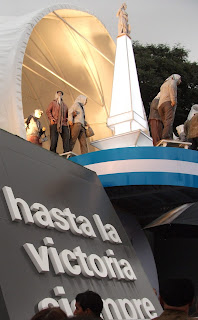30 March 2011
Boicot Productos Israelis
Today, March 30, is Palestine Land Day. The day commemorates the events of 35 years ago, when Israeli security forces shot and killed six young Palestinian citizens of Israel and injured many. The youth were among thousands protesting Israel’s expropriation of Palestinian land to build new Jewish colonies and expand existing Jewish cities. Today, Land Day symbolizes Palestinian resistance to Israel’s ongoing land expropriation, apartheid, colonization and occupation.
In solidarity with the Palestinian people’s right to self determination on their ancestral land, today also has been designated as Global BDS Day of Action. BDS stands for "Boycott, Divestments, and Sanctions" - nonviolent actions also used successfully to break up apartheid in South Africa. The need for such action is as critical in Israel. More details here.
Last weekend, in advance of Global BDS Day of Action, we helped hand out leaflets urging shoppers at the Alto Palermo mall not to patronize Maim, a store that sells Israeli cosmetics produced from Dead Sea minerals, resources stolen from Palestinians. Israel exports millions of dollars worth of cosmetics to Argentina every year. The message to shoppers: "No seas complice del apartheid Isreali en Palestina."
A short video about the activities here.
Boicot a maim PRODUCTOS DEL MAR MUERTO-Buenos Aires from julieta on Vimeo.
25 March 2011
Día de la Memoria
 |
| 2010 Bicentennial exhibit, Madres de la Plaza |
Yesterday Argentina observed Día de la Memoria por la Verdad y la Justicia (Day of Remembrance for Truth and Justice). The holiday commemorates the victims of the military dictatorship, which seized power on March 24, 1976. Tens of thousands of Argentines as well as citizens of other countries (notably Chile and Uruguay) were taken from their homes, schools, or places of business, illegally detained and tortured because of their alleged political beliefs. Some 30,000 people were killed or "disappeared," i.e., their bodies have never been found.
After the military junta was overthrown and free elections held in 1983, those who participated in these crimes against humanity were awarded an amnesty in the "interests" of national reconciliation. However, in 2006 (the year the Day of Remembrance became a national holiday), that amnesty was overturned, and many of those who ordered and/or took part in the illegal detentions, tortures, and murders were arrested and charged with the crimes. The trials are still continuing. Considerable credit for the investigations into and prosecutions of what is now known as the "Dirty War" goes to the "Madres de la Plaza" who still march every Thursday in front of the government building in Buenos Aires calling for action on their disappeared sons and daughters.
Not all Argentines agree with the trials. Some say the military dictatorship was forced to take such extreme measures because of "subversive" groups that were "terrorizing" the country. Kurt has been following several of the more famous trials; as he notes in his reports, the Argentine government had all the legal tools at its disposal to arrest, charge, prosecute, and incarcerate domestic terrorists. But the junta chose to operate outside the rule of law, turning the country into a rogue state. We do well to remember these dark moments of history.
21 March 2011
Happy Weekend
On the third weekend of most months, our bank pulls out all the stops to entice clients to use their debit (or sometimes credit) cards. We happily oblige because the savings are substantial.
"Happy Weekend" (yep, that's the term, no translation needed) offers discounts of 20% on purchases at certain supermarkets, 30% on restaurants (up to 50 pesos per day per account), and 50% on movie tickets. Happy Weekend has become routine for us; around it we plan major grocery shopping expeditions for nonperishables and staples as well as culinary excursions to old haunts or new favorites.
This past weekend we headed to the Coto (the big supermarket in the neighborhood that partners with the bank) on Friday for staples and then again on Sunday for fresh meat and other items. Supermarket savings both days: 108 pesos.
We managed two cafés on Friday, first La Biela, the iconic lunch spot right across from the Recoleta Cemetary, for a shared lunch of toasted ham & cheese sandwich (an Argentine staple) with fries, and then Piola, our latest favorite pizza place, on Libertad near 9 de Julio. Saturday featured dinner with friends at Caseros on the border of San Telmo and Barracas, for the first but not the last time. Sunday dinner was three blocks from the apartment at Los Pinos, our favorite neighborhood steak spot. Restaurant savings: 139 pesos.
Total savings: 247 pesos, or about $62 USD. It was a happy weekend.
"Happy Weekend" (yep, that's the term, no translation needed) offers discounts of 20% on purchases at certain supermarkets, 30% on restaurants (up to 50 pesos per day per account), and 50% on movie tickets. Happy Weekend has become routine for us; around it we plan major grocery shopping expeditions for nonperishables and staples as well as culinary excursions to old haunts or new favorites.
This past weekend we headed to the Coto (the big supermarket in the neighborhood that partners with the bank) on Friday for staples and then again on Sunday for fresh meat and other items. Supermarket savings both days: 108 pesos.
We managed two cafés on Friday, first La Biela, the iconic lunch spot right across from the Recoleta Cemetary, for a shared lunch of toasted ham & cheese sandwich (an Argentine staple) with fries, and then Piola, our latest favorite pizza place, on Libertad near 9 de Julio. Saturday featured dinner with friends at Caseros on the border of San Telmo and Barracas, for the first but not the last time. Sunday dinner was three blocks from the apartment at Los Pinos, our favorite neighborhood steak spot. Restaurant savings: 139 pesos.
Total savings: 247 pesos, or about $62 USD. It was a happy weekend.
12 March 2011
Empanada Night
 |
| Cross-section of the finished product |
Since moving to Buenos Aires almost three years ago, we have sampled many different styles and fillings of these flavorful turnovers: carne (both "sauve" and "picante" - though picante here does not mean what it does in Mexico), humita (a type of creamed corn), capresse (as Italian as it sounds, with mozzarella, tomato, and basil leaves), and hongos, among others. We particularly like empanadas mendocinos, the meat pies from Mendoza that are juicier than others but not to the extent of being messy. So when we finally decided to try our hands at our own home-made empanadas, we of course consulted our sources on all things mendocino, Eduardo and Stella Molteno. Additional resources included How Argentina Cooks and Eusebio, one of our favorite people at Mas Pastas, where Kurt purchased for less than 7 pesos the "masa" or preformed dough circles we used to encapsulate the meat filling. (One thing at a time . . . )
 |
| The ingredients |
Sounded good, but we wanted to incorporate some additional flavors; we had always thought that our recipe for picadillo - a treasure from Kurt's mom that melded formulas from her mother Belén and her mother-in-law Flora - could be adapted to empanadas. And of course we were right (though we have to admit that heavying up on the onion makes all the difference in the world). Here's what we devised:
- sautee in a small amount of olive oil 3 thinly sliced medium-sized onions and 1 diced green pepper
- add 1 large clove minced garlic
- add 1 pound lean ground meat, and cook just until color changes
- turn off heat
- stir in 1/2 tsp. each oregano, ground cumin, and dried parsley; 1 tsp. each paprika and red pepper flakes; freshly ground salt and pepper to taste; Tabasco or other hot sauce al gusto; 1/4 cup home-made tomato paste; and 10-12 chopped up green olives
- cover pot and let sit for 1 hour
 |
| Forming the empanadas |
 |
| Baking empanadas |
Special thanks to Waitress from Mensa, who asked quite some time ago for Argentine recipes.
Subscribe to:
Posts (Atom)



